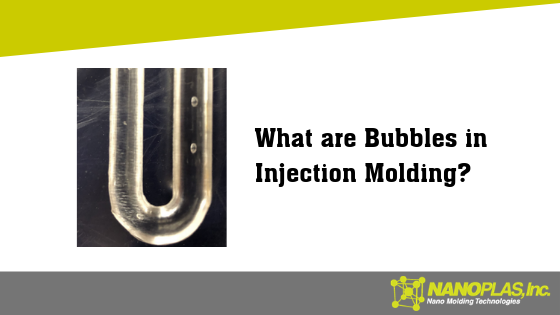
Plastic Injection Molding: Preventing Bubbles
Are you experiencing bubbles during your injection molding processes? Let’s go through the possible causes—and fixes—to get rid of bubbles.
What are Bubbles in Injection Molding?

Bubbles, sometimes known as gas traps or blisters, are cosmetic defects that detract from the looks of the part, which is especially irritating if the part will be seen. When diagnosing bubbles, you need to be careful, as the characteristics are similar to voids. Before you can troubleshoot bubbles (or voids), you need to be sure which one you’re dealing with.
Is it a Bubble or a Void?
When gas forms in the melt stream, you end up with bubbles. Voids are instances of plastic shrink that creates a vacuum in the plastic wall stock.
To determine whether you’re looking at bubbles or voids, slowly heat the area with a torch or heat gun. If it’s a void, the wall stock will collapse and show a sink. If it’s a bubble, the wall stock will swell due to the gas inside expanding.
Troubleshooting Bubbles
Once you know you’re dealing with bubbles, here are the possible causes:
| Molding Process | Mold | Machine | Material |
| High melt temperature | venting | Machine performance | Moisture content |
| Low back pressure | Hot runner temperatures | Crack in feed throat leaking water | Transparent materials |
| High decompression | Cracked water line | Screw design | contamination |
| Venturi effect | unmelts |
Table 18.1 Bubbles Troubleshooting Chart, found in Injection Molding Advanced Troubleshooting Guide: The 4M Approach (p. 166)
How to Eliminate Bubbles in Injection Molding
Try running a series of short shots as your first troubleshooting step. Doing so will help you see where the bubble begins to appear, and if it only shows up in specific locations, you can often determine the root cause.
More often than not, the cause of bubbles is excess gas in the part, which can come from high melt temperature, low back pressure or high decompression. Adjusting these settings, again using short shots if you can, could solve the problem.
Otherwise, you’ll need to run through the checklist in the table above and adjust settings as necessary.
As always, using Nanoplas’ innovative line of injection mold coatings such as Heat Cure and Quick Cure, or sprays like Tuff Kote and Dri Kote, will help avoid injection molding problems, particularly when the cause is with the mold, material or machine.
Want to learn more? Check out these other great articles that solve common injection mold issues:
- Fix Ejector Pin Marks in Your Injection Mold
- Eliminate Parts Sticking On Ejectors
- Injection Molding Buildup: Causes and Solutions
- How to Eliminate Plastic Delamination
Source: Injection Molding Advanced Troubleshooting Guide: The 4M Approach by Randy Kerkstra and Steve Brammer.

